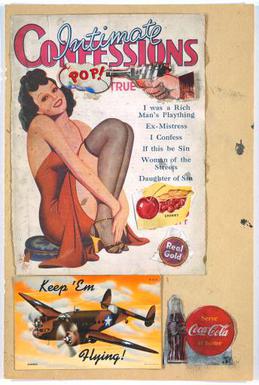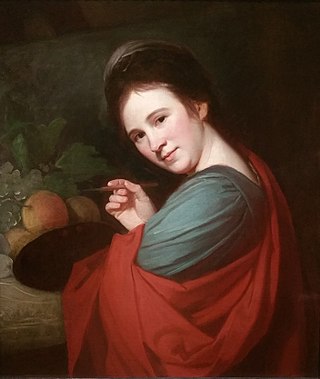Related Research Articles

Pop art is an art movement that emerged in the United Kingdom and the United States during the mid- to late-1950s. The movement presented a challenge to traditions of fine art by including imagery from popular and mass culture, such as advertising, comic books and mundane mass-produced objects. One of its aims is to use images of popular culture in art, emphasizing the banal or kitschy elements of any culture, most often through the use of irony. It is also associated with the artists' use of mechanical means of reproduction or rendering techniques. In pop art, material is sometimes visually removed from its known context, isolated, or combined with unrelated material.

Paul Muldoon is an Irish poet.

Yayoi Kusama is a Japanese contemporary artist who works primarily in sculpture and installation, and is also active in painting, performance, video art, fashion, poetry, fiction, and other arts. Her work is based in conceptual art and shows some attributes of feminism, minimalism, surrealism, Art Brut, pop art, and abstract expressionism, and is infused with autobiographical, psychological, and sexual content. She has been acknowledged as one of the most important living artists to come out of Japan, the world's top-selling female artist, and the world's most successful living artist. Her work influenced that of her contemporaries, including Andy Warhol and Claes Oldenburg.

Mary Moser was an English painter and one of the most celebrated female artists of 18th-century Britain. One of only two female founding members of the Royal Academy in 1768, Moser painted portraits but is particularly noted for her depictions of flowers.

Farrar, Straus and Giroux (FSG) is an American book publishing company, founded in 1946 by Roger Williams Straus Jr. and John C. Farrar. FSG is known for publishing literary books, and its authors have won numerous awards, including Pulitzer Prizes, National Book Awards, and Nobel Prizes. As of 2016 the publisher is a division of Macmillan, whose parent company is the German publishing conglomerate Holtzbrinck Publishing Group.
Frederick Seidel is an American poet.

Charles Kenneth "C. K." Williams was an American poet, critic and translator. Williams won many poetry awards. Flesh and Blood won the National Book Critics Circle Award in 1987. Repair (1999) won the 2000 Pulitzer Prize for Poetry, was a National Book Award finalist and won the Los Angeles Times Book Prize. The Singing won the 2003 National Book Award and Williams received the Ruth Lilly Poetry Prize in 2005. The 2012 film The Color of Time relates aspects of Williams' life using his poetry.

Soft sculpture is a type of sculpture or three dimensional form that incorporates materials such as cloth, fur, foam rubber, plastic, paper, fibre or similar supple and nonrigid materials. Soft sculptures can be stuffed, sewn, draped, stapled, glued, hung, draped or woven. These materials and techniques distinguish soft sculptures from more traditional hard sculptures made from, for example, stone, bronze or wood that are then carved or modelled.
The 10th Street galleries was a collective term for the co-operative galleries that operated mainly in the East Village on the east side of Manhattan, in New York City in the 1950s and 1960s. The galleries were artist run and generally operated on very low budgets, often without any staff. Some artists became members of more than one gallery. The 10th Street galleries were an avant-garde alternative to the Madison Avenue and 57th Street galleries that were both conservative and highly selective.
Andrea U'Ren also known as Andrea Uren and A. U'Ren is an American author and illustrator of many children's picture books. Her work has garnered several awards, including a Silver Medal from the Society of Illustrators, NY, International Reading Association's Best Book of 2004, Parents' Choice Gold award winner and a reading by Daniel Pinkwater and Scott Simon on National Public Radio of her book Mary Smith about a "knocker-up" also illustrated by Ms. U'Ren. U'Ren's other titles include Pugdog a gender bending tale, One Potato, Two Potato written by Cynthia DeFelice, Stormy's Hat, Just Right for a Railroad Man written by Eric Kimmel and "Feeding the Sheep" written by Leda Schubert.
Simon Henwood is a British artist, author, film director, and music video director. Henwood first gained attention as a children's writer and later on for his paintings inspired by adolescence, as well as combining "darkness and hip together". He is best known for directing Kanye West's "Love Lockdown" and being the creative force behind Rihanna's Rated R album campaign. Henwood was in a relationship with Irish singer-songwriter Róisín Murphy.
Judith E. Stein is a Philadelphia-based art historian and curator, whose academic career has focused on the postwar New York art world. She has written a biography of the art dealer Richard Bellamy, as well as feature articles regarding artists including Jo Baer, Red Grooms, Lester Johnson, Alfred Leslie and Jay Milder.
Ivan C. Karp was an American art dealer, gallerist and author instrumental in the emergence of pop art and the development of Manhattan's SoHo gallery district in the 1960s.

Modern sculpture is generally considered to have begun with the work of Auguste Rodin, who is seen as the progenitor of modern sculpture. While Rodin did not set out to rebel against the past, he created a new way of building his works. He "dissolved the hard outline of contemporary Neo-Greek academicism, and thereby created a vital synthesis of opacity and transparency, volume and void". Along with a few other artists in the late 19th century who experimented with new artistic visions in sculpture like Edgar Degas and Paul Gauguin, Rodin invented a radical new approach in the creation of sculpture. Modern sculpture, along with all modern art, "arose as part of Western society's attempt to come to terms with the urban, industrial and secular society that emerged during the nineteenth century".
James Bumgardner (1935–2015) was an expressionist/figurative painter, multi-media artist, and stage set designer who was a Virginia Commonwealth University professor of art in the VCU School of the Arts. As an undergraduate student at Richmond Professional Institute (RPI), Bumgardner was encouraged by his mentor Jewett Campbell to study with the notable Art Students League of New York instructor Hans Hoffman (1880–1966), and Bumgardner received the last scholarship given by Hoffman, a German-born American abstract expressionist painter. Using his scholarship, Bumgardner studied with Hoffman in Provincetown in 1957, during which time he became friends with gallery director Richard Bellamy and artist Jan Müller. In 1963 in Richmond Jim Bumgardner and Jon Bowie co-directed a series of multi-media events or "happenings". The first was called "Synthesis" and was influenced by the productions of Allan Kaprow and the ONCE Festival of New Music of Ann Arbor, Michigan. After "Synthesis" Bumgardner and Jon Bowie invited notable outside performance and visual artists who joined in a series of annual "Bang, Bang, Bang Arts Festival" happenings in Richmond.
Robert Scull was an American art collector, best known for his "world-famous collection of Pop and Minimal art". Born in New York to Russian immigrant parents, Scull dropped out of high school and had various jobs until his wife inherited a share of a taxi business. When this thrived, the couple started buying abstract art and later pop art.
Richard Hu Bellamy, was an American art dealer, known as Dick Bellamy.
The John Gibson Gallery was a contemporary art gallery in New York City, in operation from November 1967 to 2000, and founded by John Gibson. Early on, the gallery specialized in selling contemporary monumental–sized sculptures.
Jean Follett was an American painter and one of the innovators of assemblage art in the United States. She was a member of the New York abstract art movement of the 1940s and 1950s.

Richard Nonas was an American anthropologist and post-minimalist sculptor. He lived and worked in New York City.
References
- ↑ Glueck, Grace (January 3, 1986). "Robert Scull, Prominent Collector of Pop Art". The New York Times.
- 1 2 3 4 5 Stein, Judith E. (2016). Eye of the Sixties: Richard Bellamy and the Transformation of Modern Art. Farrar, Straus and Giroux. ISBN 9780374715205.
- ↑ Tomkins, Calvin (May 26, 1980). "A Good Eye and a Good Ear". The New Yorker.
- ↑ Berman, Judy (July 28, 2016). "Review/Eye of the Sixties by Judith Stein". The Guardian. Retrieved October 30, 2017.
- ↑ Smith, Roberta (April 3, 1998). "Richard Bellamy, Art Dealer, Is Dead at 70". The New York Times.
- ↑ La Prada, Erik (2009). Breaking Through Richard Bellamy and the Green Gallery 1960–1965 Twenty-Three Interviews. Midmarch Arts Press. pp. 202–205. ISBN 978-1877675782.